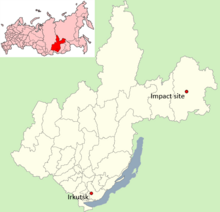2002 Vitim event
This article needs additional citations for verification. (September 2014) |

The 2002 Vitim event or Bodaybo event is believed to be an impact by a bolide (fireball) in the Vitim River basin. It occurred near the town of Bodaybo in the Mamsko-Chuisky district of Irkutsk Oblast, Siberia, Russia on September 25, 2002 at approximately 22:00 (local time, UTC/GMT +9 hours: ISO 8601 format 2002-09-25T13:00Z). The event was detected by a US military missile-defense satellite.[1]
Analysis[]
Attempts were made to define the magnitude of the explosion. U.S. military analysts calculated it was around 0.86 terajoules (0.21 kilotonnes of TNT).[1] Peter Brown estimates the total yield of both Bodiabo and Tagish Lake at about 2 kilotons—a factor of roughly 10,000 less than the Tunguska event.[1] Russian physicist Andrey Olkhovatov estimates it at 4–5 kilotons.[citation needed]
Information about the event appeared in the mass media and among scientists after only a week. A small expedition, sent by the Institute of Sun–Earth Physics (Irkutsk), tried to find a meteorite within about 10 km from Bodaybo town (people told them– "it has fallen beyond the nearest mountain").
Expeditions[]
- 1st - Russian MChS (Emergency Rescue) team tried to find an object near Bodaybo.
- 2nd - October, 2002 expedition of Irkutsk State University (leader S. Yazev).
Official expeditions in 2002–2003 never reached the impact site, situated in remote Siberian taiga.
Kosmopoisk expedition[]
As reported by the ufology organization Kosmopoisk, in May 2003 an expedition, performed by Kosmopoisk (leader — Vadim Chernobrov) reached a presumed impact point (about 50 km from Vitimsky settle point). The situation there looked similar to that of the Podkamennaya Tunguska River after the Tunguska event in 1908.[citation needed][dubious ] Snow and water samples were analyzed and found to contain an abnormal amount of tritium, as well as radioactive isotopes of cobalt and caesium.[citation needed] Chernobrov suggested that the Vitim event could be caused by a low density comet nucleus with a diameter of about 30–100 meters.[citation needed]
See also[]
- List of meteor air bursts
- Eastern Mediterranean event
References[]
- ^ Jump up to: a b c "CCNet 55/2003 - 10 July 2003". Cambridge Conference Network archive. Retrieved 2014-05-02.
External links[]
- The Vitim bolide at Meteorites Australia (Meteorites.com.au) (latest update 26 March 2006)
- CCNet bulletin 50/2003 (7 June 2003), Cambridge Conference Network archive
- CCNet bulletin 55/2003 (10 July 2003), Cambridge Conference Network archive
- Whitehouse, David (8 October 2002). "Cash plea for space impact study". BBC News. Retrieved 3 April 2014.
- Shepherd, Robin (June 7, 2003). "Siberia meteorite flattens 40 sq miles". timesonline.co.uk. Archived from the original on March 10, 2007.
- Kasatkina, E.A. & Shumilov, O.I. (2005). Some atmospheric and magnetospheric effects possibly related to the Vitim bolide impact. Retrieved June 24, 2005. [1]
- Chernobrov, Vadim & Soleny, Alexander & Lawrence, Maria (2003). Results from the VITIM-2003 expedition [2]
Coordinates: 58°16′16″N 113°27′13″E / 58.271016°N 113.453579°E
- Explosions in 2002
- Modern Earth impact events
- Explosions in Russia
- Siberia
- History of Siberia
- 2002 in Russia
- Natural disasters in Russia
- September 2002 events in Asia
